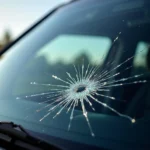Discovering a rip, tear, or burn in your car seat can be disheartening. However, you don’t need to live with the damage or spend a fortune at an upholstery shop. This guide will provide a step-by-step approach on how to repair a ripped car seat yourself, saving you money and restoring your car’s interior.
repairing-ripped-leather-car-seat|Repairing a ripped leather car seat|Image showcasing the process of repairing a ripped leather car seat using a leather repair kit. The image should clearly show the tools and materials involved, such as the leather filler, colorant, and sealant. It should also highlight the step-by-step application process for a professional-looking repair.>
Assessing the Damage: Knowing Your Enemy
Before diving into the repair, it’s crucial to evaluate the severity of the damage. A small cut will require a different approach than a large tear or a burn hole.
- Minor Cuts and Tears: These can often be fixed with a simple repair kit and some adhesive.
- Large Tears: May require patching with a matching fabric or leather piece.
- Burn Holes: These often need filling and color matching for a seamless repair.
different-types-car-seat-damage|Various types of damage on a car seat|A collage showcasing different types of car seat damage: A small cut, a larger tear revealing the foam underneath, and a cigarette burn mark.>
Gathering Your Repair Arsenal
Having the right tools and materials is essential for a successful car seat repair. Here’s what you’ll generally need:
- Cleaning Supplies: Rubbing alcohol, microfiber cloth, vacuum cleaner (with crevice attachment)
- Repair Kit: Choose a kit specific to your car seat material – leather, vinyl, or fabric car seat repair kit fabric.
- Scissors: For cutting patches or trimming excess material.
- Matching Fabric/Leather: For larger tears, find material that closely matches your car seat.
- Heat Gun or Hair Dryer: For certain types of adhesives and fillers.
The Repair Process: A Step-by-Step Guide
1. Preparation is Key:
- Thoroughly clean the damaged area and surrounding surface with rubbing alcohol and a microfiber cloth. This removes dirt, debris, and any oils that might prevent the adhesive from bonding properly.
2. Repairing the Tear:
- For Minor Cuts: Apply a small amount of adhesive from your repair kit to the underside of the tear and carefully press the edges together. Use a weight to apply pressure while it dries.
- For Larger Tears: Cut a patch of matching fabric or leather slightly larger than the tear. Apply adhesive to the underside of the patch and carefully align it over the tear, ensuring a smooth finish. Apply pressure for proper adhesion.
- For Burn Holes: Fill the hole with a leather filler or vinyl repair compound, following the manufacturer’s instructions. Allow it to dry completely.
applying-leather-filler-car-seat-burn|Using leather filler on a car seat burn mark|An image demonstrating the application of leather filler to a burn hole on a car seat. Show the filler being carefully spread and leveled within the hole, ensuring a smooth and even surface.>
3. Blending and Finishing:
- Once the adhesive or filler is dry, use a colorant from your repair kit to match the repaired area to the original car seat color. Apply in thin layers, allowing each layer to dry before applying the next.
- For leather repairs, you can use a leather sealant to protect the repair and restore its original shine.
4. Patience is a Virtue:
- Allow the repaired area to dry and cure completely before using your car seat. This might take a few hours to overnight, depending on the materials used.
Expert Insights
“Many car owners think a ripped car seat is the end of the world. The truth is, most repairs are quite manageable with the right approach. Take your time, follow instructions carefully, and don’t be afraid to seek professional help if needed.” – Mark Stevenson, Senior Auto Upholstery Technician
Frequently Asked Questions
Q: Can I use super glue to repair a ripped car seat?
A: It’s not recommended. Super glue can create a stiff and noticeable bond that might crack or peel over time. Opt for a flexible adhesive specifically designed for car seat repairs.
Q: My car seat has faded color. Can I fix that too?
A: Absolutely! You can find leather or vinyl dye designed to refresh the color of your car seats. Follow the product instructions for best results.
Need More Help?
Car seat repairs can be tricky, and every situation is unique. For personalized advice or assistance with your car seat repair, feel free to reach out to our expert team via WhatsApp: +1(641)206-8880, or email us at [email protected]. We’re available 24/7 to assist you!

